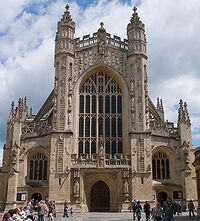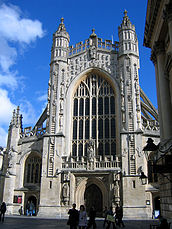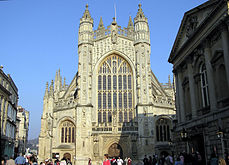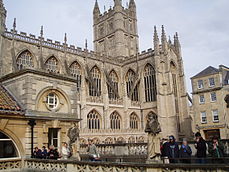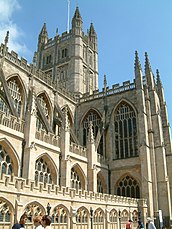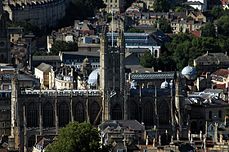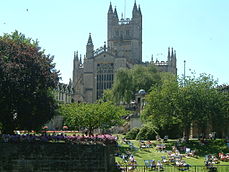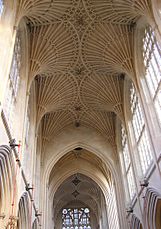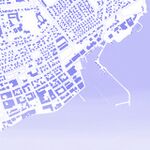Inscríbete y crea tu propia colección de obras y artículos
Diferencia entre revisiones de «Abadía de Bath»
Ir a la navegaciónIr a la búsqueda
(→top: clean up, añado {{A}}) |
m (Texto reemplazado: « » por « ») |
||
| Línea 1: | Línea 1: | ||
{{A}} | {{A}} | ||
[[Archivo:060529-17-BathAbbey.jpg|thumb|right|200px|Portada de la Abadía de Bath]] | [[Archivo:060529-17-BathAbbey.jpg|thumb|right|200px|Portada de la Abadía de Bath]] | ||
La '''Abadía de San Pedro''' en Bath (Somerset, Inglaterra), más conocida simplemente como '''Abadía de Bath''' es una [[iglesia]] anglicana, y anteriormente un [[monasterio]] Benedictino. Fundada en el siglo VII, reorganizada en el siglo X y reconstruida en los siglos XII|XII y XVI, es uno de los mayores ejemplos de Gótico Perpendicular del sudoeste de Inglaterra. Se trata de una iglesia de planta [[cruciforme]], con capacidad para aproximadamente 1.200 personas. Se emplea para servicios religiosos, ceremonias civiles y conferencias.<ref>{{Cite web|url=http://www.bathabbey.org/|title=Bath Abbey|accessdate=2007-09-27|format=|work=Bath Abbey }}</ref> | La '''Abadía de San Pedro''' en Bath (Somerset, Inglaterra), más conocida simplemente como '''Abadía de Bath''' es una [[iglesia]] anglicana, y anteriormente un [[monasterio]] Benedictino. Fundada en el siglo VII, reorganizada en el siglo X y reconstruida en los siglos XII|XII y XVI, es uno de los mayores ejemplos de Gótico Perpendicular del sudoeste de Inglaterra. Se trata de una iglesia de planta [[cruciforme]], con capacidad para aproximadamente 1.200 personas. Se emplea para servicios religiosos, ceremonias civiles y conferencias.<ref>{{Cite web|url=http://www.bathabbey.org/|title=Bath Abbey|accessdate=2007-09-27|format=|work=Bath Abbey }}</ref> | ||
<!-- | <!-- | ||
==History== | ==History== | ||
===Early history=== | ===Early history=== | ||
| Línea 10: | Línea 10: | ||
===The Middle Ages=== | ===The Middle Ages=== | ||
Following the death of [[William the Conqueror]] in 1087, Bath was ravaged in the struggle for power between his sons. The victor, [[William Rufus]], granted the city to a royal [[physician]], [[John of Tours]], who became Bishop of [[Wells]] and [[Abbot]] of Bath.<ref name=Powicke205>{{Cite book | last= Powicke | first= Maurice | authorlink= F. M. Powicke | year= 1939 | title= Handbook of British Chronology | pages= pp. 205 | isbn= 0901050172}}</ref> | Following the death of [[William the Conqueror]] in 1087, Bath was ravaged in the struggle for power between his sons. The victor, [[William Rufus]], granted the city to a royal [[physician]], [[John of Tours]], who became Bishop of [[Wells]] and [[Abbot]] of Bath.<ref name=Powicke205>{{Cite book | last= Powicke | first= Maurice | authorlink= F. M. Powicke | year= 1939 | title= Handbook of British Chronology | pages= pp. 205 | isbn= 0901050172}}</ref> | ||
Permission was given to move the [[Episcopal see|see]] of Somerset from [[Wells Cathedral|Wells]] – a comparatively small settlement – to the then [[Defensive wall|walled]] [[city]] of Bath.<ref>{{Cite book | last= Barlow | first= Frank | authorlink = Frank Barlow (historian)| title= William Rufus | pages= pp.182 | publisher= Yale University Press | date= March 2000 | isbn= 0300082916}}</ref> | Permission was given to move the [[Episcopal see|see]] of Somerset from [[Wells Cathedral|Wells]] – a comparatively small settlement – to the then [[Defensive wall|walled]] [[city]] of Bath.<ref>{{Cite book | last= Barlow | first= Frank | authorlink = Frank Barlow (historian)| title= William Rufus | pages= pp.182 | publisher= Yale University Press | date= March 2000 | isbn= 0300082916}}</ref> | ||
This was effected in 1090. John therefore became the first Bishop of Bath, and St Peter's was raised to [[cathedral]] status. Since the roles of bishop and abbot had been combined, from then on the monastery was run by its prior, and so became a [[priory]]. John of Tours planned a new cathedral on a grand scale, dedicated to [[Saint Peter]] and [[Paul the Apostle|Saint Paul]], but only the [[ambulatory]] was complete when he died in December 1122.<ref name=Powicke205/> He was buried in the cathedral.<ref name=BHOBath>{{Cite web | url= http://british-history.ac.uk/report.asp?compid=34341 | work= British History Online | title= Bishops of Bath and Wells 1066-1300 |accessdate= 2007-09-27}}</ref> | This was effected in 1090. John therefore became the first Bishop of Bath, and St Peter's was raised to [[cathedral]] status. Since the roles of bishop and abbot had been combined, from then on the monastery was run by its prior, and so became a [[priory]]. John of Tours planned a new cathedral on a grand scale, dedicated to [[Saint Peter]] and [[Paul the Apostle|Saint Paul]], but only the [[ambulatory]] was complete when he died in December 1122.<ref name=Powicke205/> He was buried in the cathedral.<ref name=BHOBath>{{Cite web | url= http://british-history.ac.uk/report.asp?compid=34341 | work= British History Online | title= Bishops of Bath and Wells 1066-1300 |accessdate= 2007-09-27}}</ref> | ||
| Línea 41: | Línea 41: | ||
===Monuments=== | ===Monuments=== | ||
[[Archivo:WilliamBinghamMemorialBathAbbey20040731 CopyrightKaihsuTai.jpg|right|thumb|[[William Bingham|Bingham]] memorial]] | [[Archivo:WilliamBinghamMemorialBathAbbey20040731 CopyrightKaihsuTai.jpg|right|thumb|[[William Bingham|Bingham]] memorial]] | ||
The Abbey is home to several notable [[memorials]], including those dedicated to [[Beau Nash]], Admiral [[Arthur Phillip]], [[Isaac Pitman]], James Montague (Bishop of Bath and Wells), Lady Waller (wife of [[William Waller]], a [[Roundhead]] military leader in the [[English Civil War]]), Elizabeth Grieve (wife of James Grieve, physician to Elizabeth, Empress of Russia), [[Sir William Baker]], [[John Sibthorp]], [[Richard Hussey Bickerton]], [[Admiral]] [[Arthur Phillip]] (first Governor of Australia), [[William Hoare]], [[Richard Bickerton]] and US Senator [[William Bingham]]. | The Abbey is home to several notable [[memorials]], including those dedicated to [[Beau Nash]], Admiral [[Arthur Phillip]], [[Isaac Pitman]], James Montague (Bishop of Bath and Wells), Lady Waller (wife of [[William Waller]], a [[Roundhead]] military leader in the [[English Civil War]]), Elizabeth Grieve (wife of James Grieve, physician to Elizabeth, Empress of Russia), [[Sir William Baker]], [[John Sibthorp]], [[Richard Hussey Bickerton]], [[Admiral]] [[Arthur Phillip]] (first Governor of Australia), [[William Hoare]], [[Richard Bickerton]] and US Senator [[William Bingham]]. | ||
| Línea 80: | Línea 80: | ||
Archivo:Bath Abbey from Beechen Cliff July 2007.jpg|La Abadía vista desde Beechen Cliff | Archivo:Bath Abbey from Beechen Cliff July 2007.jpg|La Abadía vista desde Beechen Cliff | ||
Archivo:Bath abbey 2.JPG|Vista desde el este | Archivo:Bath abbey 2.JPG|Vista desde el este | ||
Archivo:Bathabbey at night amcm.jpg|Fachada norte | Archivo:Bathabbey at night amcm.jpg|Fachada norte | ||
Archivo:Bath Abbey Fan Vaulting - July 2006.jpg|La nave, en dirección oeste | Archivo:Bath Abbey Fan Vaulting - July 2006.jpg|La nave, en dirección oeste | ||
Archivo:Bath.abbey.nave.arp.jpg|La nave, en dirección este | Archivo:Bath.abbey.nave.arp.jpg|La nave, en dirección este | ||
Revisión del 15:12 20 ene 2018
La Abadía de San Pedro en Bath (Somerset, Inglaterra), más conocida simplemente como Abadía de Bath es una iglesia anglicana, y anteriormente un monasterio Benedictino. Fundada en el siglo VII, reorganizada en el siglo X y reconstruida en los siglos XII|XII y XVI, es uno de los mayores ejemplos de Gótico Perpendicular del sudoeste de Inglaterra. Se trata de una iglesia de planta cruciforme, con capacidad para aproximadamente 1.200 personas. Se emplea para servicios religiosos, ceremonias civiles y conferencias.[1]
Otras imágenes
Referencias
- ↑
Bath Abbey. Bath Abbey. Consultado el 2007-09-27.
